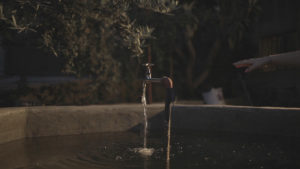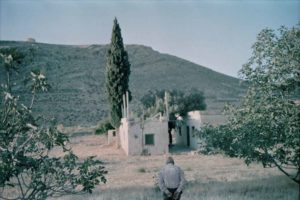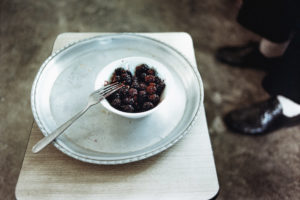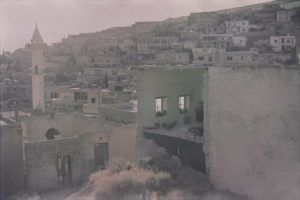São Paulo – “‘Tcharafna’ is what you say when you meet someone, like ‘please to meet you.’” That’s how artist Gui Mohallem explains the name of the section of his website featuring photos and videos of his trip to Lebanon. He visited the country his ancestors came from like someone who recognizes a part of themselves. “We’re much more Lebanese than we realize,” he said in a phone interview with ANBA.
Born in Itajubá, Minas Gerais, the artist noticed how the foods and habits were similar when sitting at the table with his Lebanese cousins. “In Lebanon, I realized something I hadn’t noticed before. The afternoon snack at my cousins’ was the same we had [at my home] in Brazil. And at the same time, too. The only difference was that they had tea instead of coffee. My mother was the one who brough this Lebanese culture in the beginning of the [last] century. And this remains to this day,” he said.
At the table, za’atar, tomatoes, olives, curd, and cake. Sometimes cake with curd. That’s the household led by Rafic Youssef El Mouallem and Miriam Mohallem. He was born in Lebanon and came to Brazil at 19, while she is the daughter of Lebanese parents. They contributed in different ways to stay in touch with their origins, whether it was through cuisine or the Arabic words they used in card games.

Gui Mohallem was born on the second floor of his parents’ textile factory. His family also has a farm, which used to hold dairy and beef cattle and now holds crops like banana and certified organic coffee. “I always visit Itajubá. Despite travelling a lot for work, I like being around, cooking with my mother. Being in the farm, where my father plants figs, Lebanese grapes,” he said. The artist has lived in São Paulo for 24 years.
Photography and art
His love for arts emerged in a trip out of the country. “I’m the fifth child of a large family, the youngest, so I had opportunities like studying abroad. There I tried to learn things I had’nt know how to do. I studied woodworking, theater, and I took a course on audiovisual arts. I loved it, so I went on and studied Cinema and Video at the University of São Paulo,” he said.

In parallel to college, Mohallem started photographing. “Then I worked for Folha de S. Paulo, Bravo [magazine]. I started a professional career as an artist, I did an exhibition in New York in 2008, then in Brazil. And I started mixing photography and video. I launched my first book in 2012, and that was the year when a I successfully applied to a program of the Ministry of Culture to visit Lebanon, he said.
Going back to Lebanon
With the material he developed during his trip, the artist did an exhibition in Belo Horizonte, Minas Gerais. In this first trip, the artist brough more work. “On my father’s birthday, when he turned 80, I went back and brought a gift. A video of people from our family telling stories. I came back and went straight to the farm, I remember him watching, and he started responding [to the people in the video], and I explained, ‘Dad, they can’t hear you.’ And he just said, ‘Let me play around.’ On that day I could see it in his eyes that he was crying. It was very beautiful,” he said.

In a kind of exchange of video-letters, the artist returned to Lebanon in 2013 with a video of his father responding to their family. On the journey, Mohallem visited another uncle. “My father’s brothers were spread across Lebanon, France, Brasília, while he is in Itajubá. I became very close to my uncle in France, and in late 2017, he said he wanted me to bring him to Brazil. I brought him, and one month later, my uncle from Lebanon came as well. And then the four siblings were reunited for the first time in 54 years,” he recalled.

The closeness to his family and his role as a link helped Mohallem to connect with his own history. “Lebanon is a search for belonging. Because living with these identities as an LGBT person and a Lebanese, this seemed like an incompatible narrative. Then as I started building this sense of belonging, becoming an ambassador of my father, on top of being an LGBT activist, was a huge step towards this conciliation. Despite my own work I should take the credit for, this generation has a willingness to look to the new and say, ‘Ok, this is my child, and we’ll go together,’” the artist stressed.
In his works, other mixtures. They can be seen in medias like photo, video, sculptures and art installation, like the most recent one he made in the Brazilian Museum of Sculpture and Ecology, and an exhibition that’s being held in Orlando, United States. They are also in the work as a whole, as Mohallem also works – and was a founder of – Vote LGBT, an initiative that aims to boost the representation of LGBT+ people in politics. “I incorporated elements of Vote LGBT within the contemporary arts. In this moment of life, I’m in an intersection between art and activism work. And one thing feeds the other,” he concluded.
Contact details
Instagram: @gui.mohallem
Website: www.guimohallem.com
Translated by Guilherme Miranda




